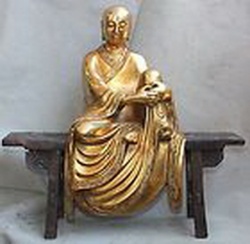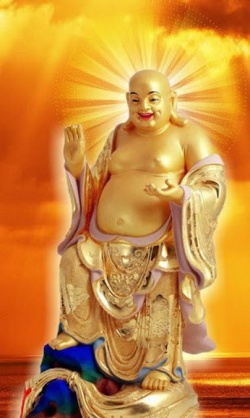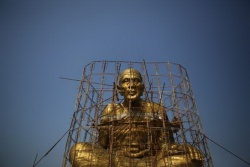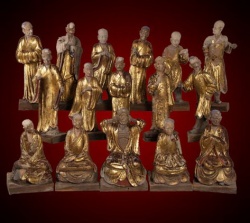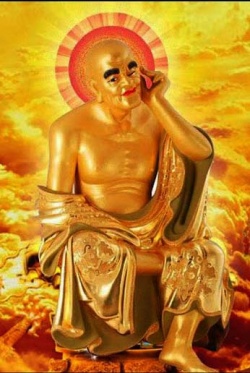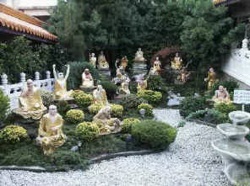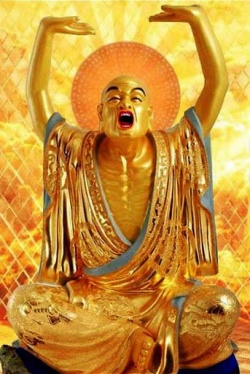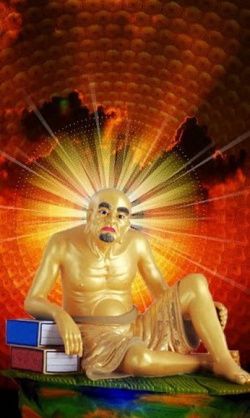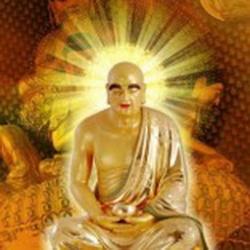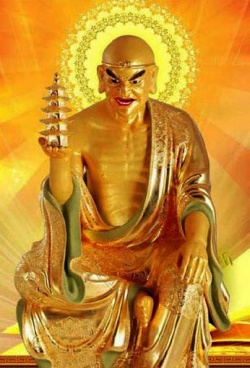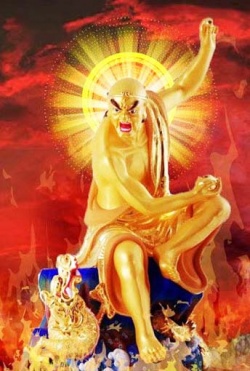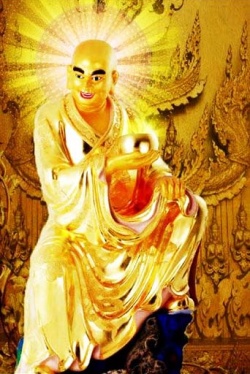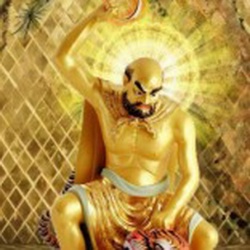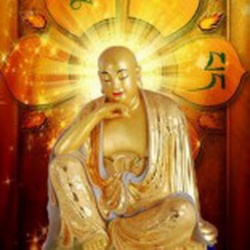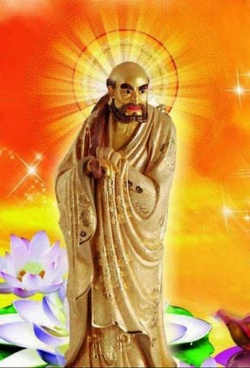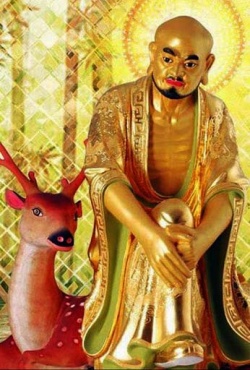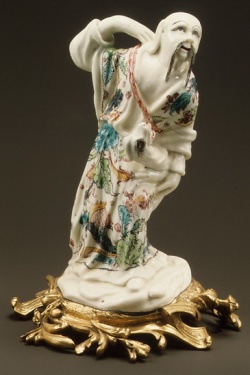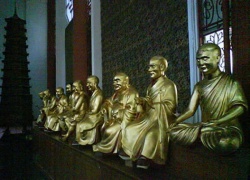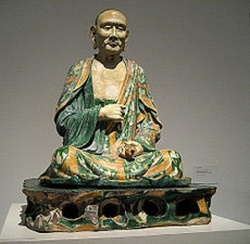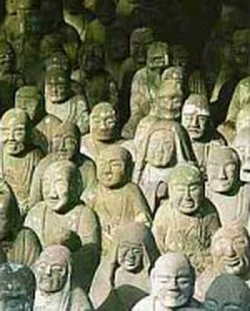The 16 Arahats
According to Waters (1890's,) in the main hall of Chinese Buddhist temples were two rows of large yellow figures -- one along the east and an other along the west wall.
They are the numbered, labeled figures known as the Eighteen Lohan, (16 plus 2 patrons) or Buddha's great disciples called in Sanskrit, shravaka or the hearers.
However, the names given show that the information is not quite correct since some are unknown to the original Buddhist canon.
In old Buddhist temples of Korea, the similar figures are sixteen in number.
In Japan, the Rakan also number only Sixteen. ( Lohan and Rakan derive from Alohan, the Chinese pronunciation of Arahant or Pali, Arhat. )
In Tibetan these figures are called Natan Chudug from Sanskrit, 16 sthaviras.
Text on the back of Wisdom Publications Tibetan calendar for 1996 says that Lamas Lumes and Dromchung introduced them to Tibet after they had visited China.
In Tibet, they are considered custodians of the Buddha's spoken word and function as guardians of his teachings.
Jeff Watts' notes at Tibet Art tell us that the sadhana or ritual service and offerings to Buddha Shakyamuni with the 16 Arhats was made popular by Atisha (982-1054) and the Shakya pandita, Shribhadra (1127-1225).
Following tradition, at Khenchen Thrangu Rinpoche's Vajra Vidya Institute in Sarnath, in the main shrine room, a set of eight appear along the east wall, and the other eight are against the west side:
They are placed on the walls according to their rank, with the most senior closest to the main Buddha statue.
The two attendants, Huashang and Dharamatala are placed along the south wall.
They are both laymen; Huashang is the plump Chinese sponsor who is surrounded by playful children and Dharmatala is the great Indian master who can be seen carying a basket of texts.
They are not considered as part of the sixteen original arhats since they are laymen and not monks, but are always pictured as part of the group.
[1] Angaja holds a fly whisk and incense bowl.
[2] Ajita has the head covered and the hands in the meditation mudra.
[3] Vanavasin with the mudra of explication and holding a fly whisk.
[4] Kalika holds a gold earring in each hand.
[5] Vajriputra with a fly whisk and hand gesture.
[6] Bhadra performs the mudras of explication and meditation.
[7] Kanakavatsa holds a jewel lasso in both hands.
[8] Kanaka Bharadvaja has both hands in meditation.
[9] Bakula holds a mongoose.
[10] Rahula holds a jewelled tiara.
[11] Chudapantaka has both hands in meditation.
[12] Pindola Bharadvaja holds a book and begging bowl.
[13] Pantaka holds a book and performs the mudra of explication.
[14] Nagasena holds a vase and staff.
[15] Gopaka holds a book.
[16] Abheda holds a stupa.
The arhats have incense burnt before their images but generally speaking they are not worshipped or consulted like gods and divinities. Where does the doctrine of an elite group of disciples originate?
Buddhist literature, once preserved in the libraries of great Chinese monasteries, mentions only sixteen "the number eighteen being apparently unknown even to the comparatively modern [1894] native treatises."
The likenesses derive from the works of one or two T'ang dynasty painters.
About the year 880, according to Waters, an artist named Kuan Hsiu made pictures of the 16 which were given to a Buddhist monastery near Ch'ien-t'ang in the province of Zhejiang (Chekiang.)
These became famous and were preserved with great care and ceremonious respect.
In the reign of Qianglong [or, Chen-lung) (ca. 1750) an official had copies made by competent artists and sent them to the emperor who had further copies made, printed and distributed.
When it was found that names were incorrectly assigned, he took care to see that the copies be compared with the originals and correctly transcribed.
Who are these Arhats?
Buddhist scripture indicates that they are the patrons and guardians of Shakyamuni Buddha's system and of its adherents both lay and monastic.
An early mention of spiritual protectors of Buddha's religion after his decease is found in the Sutra of Shariputra's Questions.
It was brought to China where its translation is considered fourth century CE.
Here the Buddha is said to have committed his religion to the protection of Shakra (the god (deva) Indra) and the four Devarajas.
The propagation of his system was entrusted to the four Great Bhikshus: Mahakashyapa, Pindola, Kun-te pan-t'an and his son, Rahula.
These were to remain in existence and not experience final Nirvana until the advent of Maitreya as Buddha.
Three of the names are well known, and the characters of the unknown one according to Waters, indicates Kundovahan, a Pali name meaning "Mongoose-bearing," according to a spelling from a sutra of the last century BCE.
Then in a treatise or shastra composed in the 1st century of our era and translated into Chinese in 384 CE, the title of which is Arya Vasumitra-bodhisattva Sangiti Shastra, we find mention of sixteen "brahmins" -- the word Buddha used to designate the "exalted" or "noble ones" -- that is, the bodhisattvas.
Those are probably the Sixteen Arhats, although a note gives the name of the second one as Ajita, that is Maitreya.
Another treatise. the Mahayana Vataraka Shastra. composed by the learned Buddhist Sthiremati (translated into Chinese by Tao-t'ai about 400 CE) is where we have further mention of guardians of Buddhism.
Here we have ninety-nine lakhs of great arhats plus the sixteen Great Shravakas or Hearers.
But only two names are given: Pindola and Rahula.
These guardians are said to be dispersed over the world and the names of some of their spheres are: Purva-Videha, the Wheat (Godhuma) region, the Spice (Priyangu) region, the Lion (Simha) region and Bhadrika place.
The text from which all our knowledge of the names of the Sixteen Arhats of the far east is likely derived is the Record of the Duration of the Law* by the great Arhat Nandimitra.
The actual author lived long after the legendary Nandimitra and was not a native of that arhat's country, and the Chinese translators say they are indebted to a previous translation.
The Record of the Duration begins with the [[[Wikipedia:Chinese|Chinese]] Buddhist) tradition that within 800 years of Buddha's decease, an arhat named Nandimitra lived at the capital of King Sheng-chun in the Chih-shih-tzu country.
Though the scholar Nanjio took Sheng-chun to be King Prasenajit and Chih-shih-tzu to be Ceylon, Prasenajit's capital was at Shravasti in Kosala.
Besides, no king with that name is in the annals of Ceylon. And Chih-shih-tzu is probably Shih-tzu-kuo which was in Vrijjian territory.
Waters thought that the Chinese name Sheng-Chun might stand for either Prasenajit or Jayasena.
The Record narrates how Nandimitra answered the questions of his despondent congregation about the continued existence of Buddhism in the world.
He says that the Buddha when about to die entrusted his religion to sixteen great Arhats.
These people will watch over and care for the religious welfare of believers and protect the spiritual interests of Buddhism until Maitreya appears.
Then the Sixteen Arhats will collect all the relics of Shakyamuni in a magnificent stupa where they will pay their last reverence and rising in the air, do pradakshina to it.
Then "they will enter an igneous ecstasy and so vanish in remainderless nirvana."
Waters gives the list from the Record with the Chinese, Japanese, and variations noticed in other lists.
He reminds us "we must remember that these, whether merely works of art or consecrated to religion, are not supposed to be faithful representations of the men . . . .
The pictures and images are to be taken merely as symbols or fanciful creations."
At his congregation's request Nandimitra named these 16 Protectors, their spheres of action, and the size of their retinues.
According to this Record of the Duration of the Law here is the order:
Pindola Bharadvaja
He has a retinue of 1,000 arhats, and his place is the Godhanga region in the west.
Sometimes he is just called Bharadvaja. Pindola, "with a voice like a lion's roar" was one of Buddha's great disciples distinguished as a successful disputant and defender of orthodoxy.
However, he had a weakness for exhibiting his magical powers before all sorts of people, and sometimes for unworthy objects.
Once, according to the Pali and other editions of the Vinaya, in order to show his superhuman powers, he rose in the air, took a sandalwood bowl off a very high pole, and floated about with it for a time over the heads of an admiring crowd.
This brought a severe rebuke from the Master, and was the occasion of a rule prohibiting the use of sandalwood bowls (?!)
The Buddha also on this occasion said that Pindola was not to "take Nirvana," but was to remain in existence protect Buddha's system until the coming of Maitreya.
He is also said to have worked a miracle with a hill in order to go to a breakfast given by Sudatta's wife, and some make this to be the occasion on which Buddha rebuked him.
But Pindola sometimes wrought miracles for good purposes, such as at Rajagriha where it led to the conversion of an unbelieving lady.
Pindola has been living ever since Buddha's time, and he has appeared on several occasions to pious workers for Buddhism.
In India it was once the custom for lay believers when giving an entertainment to the Buddhist monks to "invite Pindola."
(As Jews invite Elijah the Prophet to the Passover feast.) The arhat could not be seen, but the door was left open for him, and it was known by the appearance of the flowers or the condition of the mat reserved for him whether he had been present (cf. Santa Claus' cookies in the USA.)
When King Ashoka summoned his great assembly, Pindola was living on Gandhamali (or Gandhamadana) mountain with a company of 60,000 arhats.
When summoned, he flew swan-like to the meeting where, on account of his undoubted seniority, he was chosen president.
He was then a very old man with white hair and long eyebrows which he had to hold back with his hands in order to see.
As he often has very long eyebrows in his pictures and images, the Chinese have come to know him popularly as the Ch'ang-mei-seng or "Long-eyebrowed Monk."
But other arahats are also depicted with this characteristic.
In the seventh century, Pindola is believed to have visited China appearing to Tao-hsuan, the great Vinaya doctor, to signify his approval.
Pindola is equated with the Chinese pu-tung or unmoved but Waters says this cannot have been intended as a translation.
Tibetans give "Alms-receiver" from the word pinda, but it may have been derived from a place transcribed as Pin-t'ou in Chinese, a town in Kosala in Buddha's time.
In a far-back existence Pindola had been a bad son and a cruel man which led to his suffering in hell for a long period.
Here his food was "tiles and stones," and even when he was born to be a pious arhat he is said to have retained this diet.
No wonder he is thin and ribbed.
Some images represent Pindola sitting and holding a book in one hand and his alms-bowl in the other; others have him holding a book reverently in both hands, and sometimes we find him with an open book on one knee and a mendicant's staff at his side.
Kanakavatsa
Kanakavatsa holds a jewel lasso in both hands as #7 in the Tibet Art image.
His region is Kashmir with a retinue of 500 other arhats.
He was originally a disciple of Buddha, and it was said of him that he comprehended all systems good and bad.
Waters says that the Tibetan name translates the Sanskrit "jewelled lasso" as "golden calf."
Kanaka Bharadvaja (Ka-no-ka Po-li-tou-she)
Kanaka Bharadvaja has both hands in meditation as #8 in the Tibet Art tangka.
This arhat's (Kanaka) place is the Purva-Videha region where he has 600 arhats under his authority.
He is sometimes pictured as a very hairy old man, and some paintings give him a small disciple at his side.
Subhinda
In Kulu country he has a retinue of 800 arhats.
(He occurs in China, Korea, and Japan but not in several other lists.)
The Tibetan gives Apita, which may be for Abhida.
The Tibetan translation is Inseparable in the sense of Indissoluble, which points to Abheda or Michepa .
This arhat appears as a venerable sage with a scroll in his right hand, or sitting in an attitude of meditation.
He is also represented with an alms-bowl and a vase beside him, holding a sacred book in the left hand, while with the right he snaps his fingers, a gesture indicative of the rapidity with which he attained insight.
Nakula (No-ku-lo)
His sphere is Jambudvipa, "Rose-apple Land" that is India; his retinue comprises 800 arhats.
As Nakula, the name is found in Chinese, Korean, and Japanese temples, but in some lists we find instead Pakula, that is Bakula or Vakula.
This was the name of one of Buddha's great disciples, often mentioned in the scriptures.
Vakula was a typical shravaka in that he led a solitary, self-contained life never preaching or teaching.
He was remarkable for his exemption from bodily ailments and for his longevity.
In the Tibet Art tangka, the name of arhat #9 is given as Bakula and he holds a mongoose.
Yuan-chuang's text also says the name means Mongoose, but recall the arhat called Kundo-vahan or Mongoose-bearer already mentioned.
When King Ashoka visited his stupa and is said to have only offered one anna (a 1,000th of a coin) N/Bakula is said to have shown disdain for the King's poor understanding of the nature of an arahat as shown by that paltry offering and he rejected it.
Could this be the origin of the magical mongoose and its jewel-spitting?
We know there is in the scriptures a father referred to as Nakulapitra father of Nakula, who is a devoted lay adherent of Buddha's teaching.
Nakula was a Vrijjian resident at Uruvilva, but there is not much about him in the scriptures.
He may be the same person that Nakulapita converted when he was 120 years old who was made young again and happy by Buddha's teaching.
He is represented with a mongoose as his emblem, but also through a mysterious transposition with the three-legged frog under his left arm.
(See also the eclipse.)
Sometimes he is represented as meditating or as teaching with a little boy by his side.
Bhadra (Po-t'e-lo)
He was appointed to T'an-mo-lo-Chow, that is, Tamradvipa or Ceylon with a retinue of 900 other arhats.
He is therefore sometimes called Tamra Bhadra.
In the Tibet Art tangka he is #6 where he makes mudras of explication and meditation.
Bhadra was a cousin of the Buddha and one of his great disciples.
He was a good preacher who could expound in clear and simple language.
Hence he is represented in an attitude of worship or as holding a book but Waters says that he can appear in pictures and images accompanied by a tiger which he soothes or restrains.
Kalika or Kala
Kalika holds a gold earring in each hand is #4 in the Tibet Art tangka.
He has 1,000 other arhats under him and resides in Seng-ka-t'a.
Though this Chinese phrase has been taken for a reference to Ceylon, this Simhata or Lion country is more probably an area in northeast India.
He seems to be the great disciple called 'Lion-king Kala' who was honoured by King Bimbisara.
He is represented as studying a scroll, or sitting in meditation, or holding a leaf of a tree, or with extremely long eyebrows which he holds off the ground.
Vajraputra (Chinese pron. Fa-she-lo-fuh-to-lo)
He has 1,100 arhats and resides in Po-la-na that is, in Parnadvipa perhaps.
Vajra Mobu (in Tibetan) is #5 in the Tibet Art list.
In some lists the name is given as Vajriputra.
This may be the Vajjiput of the village of the same name who became a disciple and attained to arhatship.
He is represented as very hairy, or as very lean and ribbed.
Gopaka or Shupaka
He resides on Gandhamadana the eastern mountain with 900 arhats.
Sometimes the name is given incorrectly as Kapaka. Waters says that it might be Gopaka.
Tibetans have both Chinese forms but translate them as Sbed-byed which would have come via Gopa meaning protector as a herder.
Also there does not seem to be mention of any disciple of Buddha named Supaka, but there is a sthavira at Pataliputra named Gopaka.
As #15 in the Tibet Art listing, Gopaka holds a book.
Representations of this arhat often show him with a small figure of a saint above his right shoulder or close to his side, but he also appears with a book or a fan in his hand.
Panthaka or Pantha (Pan-t'o-ka)
(In some books Pa- or Sanaka appear but Waters thinks those are copyist's errors. )
In the Trayashtrimsat Heaven he is attended by 1,300 arhats. Called simply Pantha or sometimes Ta or Mahapanthaka to distinguish him from his young brother who is no. 16 below.
The name is explained as "born on the road," and a legend relates how it was given to both boys because their births occurred by the roadside while their mother was travelling.
But it is also explained as "continuing the way," that is, propagating Buddhism, and the Tibetan means "doctrine of the way" but this explanation is better suited to the younger brother.
Panthaka was among the highest of Buddha's disciples, who " by thought aimed at excellence."
He holds a book and performs the mudra of explication as #13 in the Tibet Art list.
He was expert in resolving doubts and difficulties in doctrine for weaker students but he also had extraordinary magical powers or siddhis.
He could pass through solids and shoot through the air, and cause fire and water to appear at his pleasure.
He was said also to be able to shrink himself down to nothing.
These siddhis were called upon when Buddha made an expedition to subdue and convert the fierce dragon-king Apulala.
Images show Panthaka sitting under a tree or teaching from an open book, or as holding a scroll, or as sitting in profound meditation with his arms folded.
He is also frequently depicted charming a dragon (or naga) into his alms-bowl.
This Panthaka is not to be confounded with the adept by the same name who accompanied King Mahinda (Milinda) in his mission to convert Ceylon, says Waters.
Rahula ( Lo-hu-lo)
Rahula, the son of Buddha was assigned Priyangudvipa, land of aromatic herbs along with 1,100 arhats.
He will return to this world as Buddha's son for several lifetimes, and will not attain nirvana or pass finally out of existence for a very long time.
Numbered at 10 in the Tibet Art list, Rahula holds a jeweled tiara to indicate his princely status.
He was notable for his diligent study of the canon and his observance of the rules of the order.
He is often represented as having an "umbrella-shaped" head, prominent eyes and hooked nose but in many cases he has no distinctive features or attributes.
Nagasena
Appointed to Pandava Mountain in Magadha, with a retinue of 1,200 arhats he is the one referred to as 'Seni' in the Chinese texts.
He is the bhikshu noted as a teacher of the principles of Buddhism who was a monk for 30 years before he attained arhatship.
He delayed his attainment of that spiritual state so that he could complete a treatise, Abhidharma-kosha embodying the results of his studies.
Waters believes that this is the Nagasena who composed the original work which was afterwards amplified into the Questions of Milinda.
He is described as of commanding presence, proud and learned, subtle-minded and ready-witted as he is tested by the king's questions.
A contemporary of the Buddha and Shariputra, he is also supposed to be living long after Buddha's time.
And while he is called arhat by the author of the introduction to the "Questions," in the body of the book he is not an arhat.
In the discussion, he defends the unity and consistency of Buddha's teachings, and explains and expands hard doctrines with great learning and richness of illustration.
He then becomes "the head of the Church in Milinda's country to watch over and maintain Buddhist orthodoxy."
His treatise must have existed in various lands and in different forms from a comparatively early period since the various Chinese versions seem to quote from a text earlier than the "Questions," as we know it.
Angida or Angaja (Yin-kie-t'e)
He resides at Broad-side or Vipulaparshva with a retinue of 1,300. Angaja is #1 in the tangka at Tibet Art ; he holds a fly whisk and incense bowl.
Other Tibetan tran scriptions have Angija, Angida, or Angila according to the Waters' article.
One of Buddha's great disciples was named Angaja who was noted for the cleanness and fragrance of his body.
Angila who was described as being perfect in all things is probably the same person.
Other images make him a lean old monk with a staff and a book containing Indian writing.
This latter is the older traditional representation handed down from the T'ang dynasty.
On Habitable Mountain, with a retinue of 1,400 sits this arhat in a cave meditating with eyes closed, or his hands make a mudra, or he hugs his right knee.
Ajita or Ashita
Ajita is the name of the #2 arhat in the Tibet Art tangka where his head is covered and his hands are in a meditation gesture, but Waters says that since that name usually refers to Maitreya, the Bodhisattva who is to remain in Tushita Paradise until the time comes for him to incarnate on this earthe would not be one of the 16.
Ashita resides on the Gridhrakuta Mountain with 1,500 arhats.
The images and pictures generally represent the arhat as an old man with very long eyebrows, hugging his right knee or absorbed in meditation.
There is an old seer Asita who came from his distant home to see the newly-born infant who will become Buddha.
Waters doubts that he is the same as the arhat.
Chota-Panthaka (Chu-ch'a, T'a-Pan-t'o-ka)
The Sanskrit Kshulla, cf. Pali Chulla, became the Hindi Chota that is still used for small today.
This Panthaka is called by that epithet to distinguish him from his elder brother, #10 above.
(In Chinese: Hsiao-lu or Little Road and Ta-lu, Great Road.)
Chudapantaka has both hands in meditation as #11 in the Tibet Art list.
Chota-Panthaka is with 1,600 arhats on Ishadhara Mountain, part of Sumeru.
As a disciple Little Pantha was at first and for a long time exceedingly dull and stupid as a result of karma.
It is said that he could not apply his mind or commit to memory even one stanza of doctrine.
He was slighted by the sangha their patrons, but the Master always had pity and patience.
Once the King invited Buddha and the disciples to breakfast, but Little Pantha was excluded.
When Buddha discovered this he refused to sit down until the despised disciple joined them.
Later, when Little Pantha was expelled by his brother for his stupidity, Buddha would not allow it and brought him back comforting the sorrowing disciple and gave him the words "Sweeping broom" as his practice.
With that mantra and accompanying practice his mind was "stimulated, and he came to see that the two words meant that all attachment to things of this world was defilement and to be swept away by the broom of Buddha's doctrine."
He achieved perfection, and became noted as one of the first disciples in 'mental aiming at excellence'; he was chiefly occupied with the mind and mental contemplation."
Later, he "expounded these with such power and eloquence that even giddy nuns, who came to laugh and mock, remained to be impressed and edified."
Little Pantha also later accomplished the powers of flying through the air and of assuming various forms. Once he produced 500 "strange oxen" and proceeded to ride one.
He is sometimes pictured as an old man sitting leaning against a dead tree, one hand having a fan and the other held up in the attitude of teaching.
He is also represented as a venerable sage sitting on a mat-covered seat and holding a staff surmounted by a hare's head.
17 and 18 ?
There does not seem to be any historical account of the first introduction of the arhats into the Halls of Buddhist temples, nor can it be ascertained when the number was raised from sixteen to eighteen in Chinese temples.
The number of the Lohan was sixteen, e.g. in the Pao-ning-ssu near Mount Omi visited by Baber in Travels and Researches in Western China a hundred years ago.
Some Chinese have supposed that there were formerly 18 gods regarded as protectors, but more probable is the idea that the Buddhists imitated a certain 7th century Chinese institution:
In 621, T'ai Tsung instituted within the palace grounds a select college composed of 18 members who were learned scholars and loyal statesmen.
They took turns tending to duty in threes and while in the college were liable to be visited and interrogated by the emperor.
He had portraits made for the college, and each was labeled the name, birthplace and honours of the original.
They became known as the Eighteen Cabinet Ministers, and were popularly said to have teng-ying-chou or Immortals.
Waters thinks that it is this Hall of the Eighteen which led to the idea that there ought to be Eighteen Arhats in Buddha's Hall.
He thinks that in China the characteristics of the two groups became intermingled and that this was further confounded by the fact that in some temples the Lohan are arranged in groups of three.
Eighteen Lohan have never received authoritative recognition, and are not given even in [late 19th century] Buddhist treatises.
We find this number "occasionally in modern Chinese works of art.
The South Kensington Museum has a pair of bowls on which they are painted, and the British Museum has them on an incense-vase.
This vase is remarkable for departing so far from the established doctrine of the Lohan as to represent three of the eighteen as boys or very young men."
There the Chinese artist, followed by the Japanese, takes the Lohan to be Immortals since he shows them crossing to the Happy Land or leading lives of unending bliss among the pines of misty mountains.
Different worthy individuals have been added to make up the full number of 18 in the different places.
In many old temples we find the 17th and 18th places given respectively to Nandimitra and a second Pindola.
This Nandimitra ( Chinese Ch'ing-yu) is the arhat already mentioned as the author of the Record describing the Sixteen Arhats.
Sometimes we find the Chinese Imperial patron of Buddhism, Liang Wu Ti ( 502 to 550 CE) or Kumarajiva, the great translator who flourished about 400 added to the 16.
In some temples, Maitreya or his supposed incarnation, Pu-tai ho-shang, hempen or Calico-bag (cushion) Monk is added He is the special patron of tobacco-sellers and his jolly little fat image often adorned shop-fronts.
This sixth century [CE] monk was not honoured as a Lohan until modern times.
Another interesting person sometimes found among the Eighteen Arhats is the Indian master Dharmatara (or Dharmatrata,) in Chinese Fa-Chiu.
This may be the Dharmatara who was a great master of dhyana or meditation, and a learned author, and who probably lived about the middle of the first century of our era.
He is sometimes called a great upasaka or adept, and is represented as receiving or introducing the Sixteen (or Eighteen) Lohan.
Chandra [[Wikipedia:Sarat Chandra Das in Narrative of a Journey to Lhasa (145) wrote that:
In the Na-chu Lha Khang Chapel erected by one of the Sakya Lamas named Wang Chhyug Tsondu, were the most remarkable statue-like images of the Sixteen Sthaviras called Natan Chudug, arranged to represent the scene of their reception by Upashika Dharma Tala, one of the most celebrated and devout Buddhists of ancient China.
Waters noticed this saying that "Dharma Tala" is Dharmatara who was not Chinese but Indian.
He adds that in many Chinese temples Kuanyin P'usa appears as one of the lohan sometimes in the capacity of a dharma protector.
Gelongma Palmo's notes on the arhats.
=============================================
Other Prominent Figures
In the legend of the events following Buddha's first teaching, Theravadins tell how Assaji, one of his five former companions, while out begging for alms, met two followers of a famous nihilist philosopher called Sanjaya Belatthiputta.
Those two students, Shariputra and Maudgalyayana, impressed by Assaji's composure and air of contentment, were the next to join the sangha of Shakyamuni, along with all the other 250 disciples of the nihilist.
That is the reason why, especially in Chinese depictions of Buddha, Shariputra and Maudgalyayana are depicted as figures larger than the other members of the group.
In Tibetan tangkas of the 16 arhats, there also appear other figures such as two attendants, the plump Hvashang, surrounded by playful children and the above-mentioned Dharmatala or -tara, seated upright who may also be the one accompanied by a tiger.
That makes the "18 arhats."
At the bottom of a scroll or poster of the arhats so that there are often 22 figures, may stand the 4 Guardians of the Directions (Skt: Devarajah) in their Mongolian-style armour and multi-coloured robes.
They are Virupaksha (Tib: chen mi zang dang) red lord of the West, naga-ruler holding a chaitya or reliquary and Virudhaka (Tib: pag pi kye bo) blue king of the South and ruler of the dwarves, holding his sword.
Dhritarashtra is the white king of the East and of the Gandharvas or celestial musicians holding a lute.
Often in the centre is the golden yellow guardian of the North, king of the Yakshas, Vaishravana (Tib: Nam Toseh) holding a victory banner.
In compositions featuring the arhats, there are generally a total of 23 figures with Amitabha, but 24 if we include Buddha Shakyamuni.
====================================
At the southern center for kung fu (Nam Siu Lam Ji in Fukien province, China) the wooden dummies used to test the skills of martial arts students are related to the Lohan.
The information here is mainly from the annotated text version of Waters' 19th-century article. T. "The Eighteen Lohans of Chinese Buddhist Temples," The Journal of the Royal Asiatic Society, 1898. v. 4 (329-347.)
There are various copies to be found on the Internet, almost all with textual errors -- one which, though it includes the Chinese characters, does not even correctly cite the author's name! </poem>
